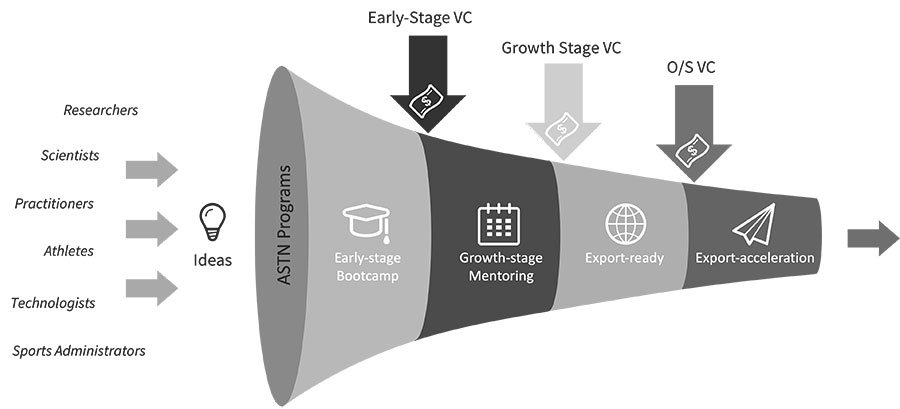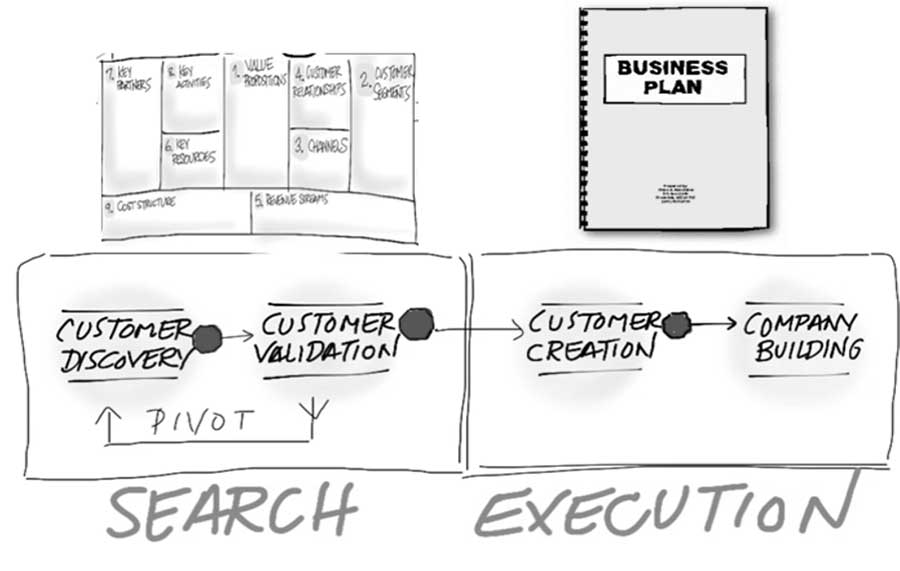ASTN’s ‘Playbook’ has startups ‘thinking global’ from day one in order to thrive

Australia: A gold-medal sporting ecosystem for validating sports innovations
Local sports industry stakeholders sometimes take for granted the unique sporting environment that Australia has created over generations. This environment provides businesses with the perfect foundation to develop and validate globally significant sports technologies.
Australia’s great global sporting reputation is built on a track record of sporting excellence that continually inspires the next generation of participants, fans and industry leaders. But there are many other characteristics of our sporting nation that also contribute to this reputation:
- Major Sports Events: Australia has developed some of the world’s best sporting precincts on the doorstep of our major cities which host a multitude of world-class major sporting events and professional sporting teams year-round. We are recognised amongst the world’s leaders for hosting and managing major sport events.
- Community Sports Development: Australia has created well-structured sports systems, development programs and athlete pathways, complimented by excellent access to multi-sports facilities and precincts that feed community sports participation.
- Sports Science and Management Expertise: Australia has pioneered and delivered some of the world’s best sports science, sports medicine and sports management curriculum to over 30 years of graduates that are employed at major sports clubs, leagues, teams and events around the world.
These characteristics provide the platform, the melting pot and the unique sports ecosystem that has helped Australia become one of the top six sportstech regions of the world (which includes North America (USA and Canada), United Kingdom, DACH (Germany, Austria and Switzerland) and Israel. And this environment provides the foundation for the ASTN in developing its ‘Sportstech Startup Playbook’ to success.
The Aussie ‘Born Global - Thrive Local’ Sportstech Start-up Playbook
In 2014 ASTN had the privilege of hosting two of the world’s leading technology, innovation and entrepreneurship educators at the ASTN Annual Conference – Prof. Jerry Engel from the University of California, Berkeley and Prof. Steve Blank from Stanford University and author of The Start-up Owners Manual.
Prof. Engel had been part of ASTN’s journey from day one, having facilitated a workshop on exploring the need to establish an organisation like the ASTN in late-2011. His colleague and friend, Prof. Blank was impressed with the capability and capacity of the Australian sports technology ecosystem and what ASTN had achieved in trying to coordinate and build the ecosystem in less than three years. However, he emphasised that Australia as a market was very small, geographically far away from key global markets and had limited access to technology, startup investment and human capital - unlike Silicon Valley in the USA where he had spent most of his successful technology career.
Prof. Blank also highlighted that as a rule of thumb a market of 100 million people is required to build a business of significant size and scale, and that Australian startups needed to ’think global’ from day one. He stressed that if they failed to do so, they would ‘die’ just servicing the small regional Australian sports market of 26 million people.
He noted that the tactics and strategies for success of sportstech companies from Australia were very different to that of sportstech companies in Silicon Valley. Consequently, ASTN needed to lead the development of an industry ‘Playbook’ that detailed the strategies and tactics specific to Australia’s own sportstech industry on how to build a successful, scalable and globally significant sportstech company1.
Based on Prof. Blank and Prof. Engel’s recommendations, the ASTN developed what is referred to as the ASTN ‘Born Global or Die Local’ Playbook to document and then share knowledge and best practice with the next generation of sportstech companies to fast-track their journey. This knowledge has been built on ASTN’s engagement with hundreds of sportstech companies both here in Australia and internationally which has helped us to understand what it takes to both succeed and fail.
ASTN’s executive team has also travelled extensively to key markets across the world to better understand global opportunities and priority international markets. Importantly, key elements of the Playbook’s tactics and strategies have been embedded into ASTN’s programs including the early-stage ASTN-GSIC (powered by Microsoft) Pre-Accelerator Program, the growth-stage ASTN Startup Accelerator Program as well as trade mission and business matching activities to priority markets for export-growth companies (see Figure 1).

Figure 1: ASTN Program Pipeline
Spotlight on three themes commonly overlooked by sportstech founders
ASTN’s Born Global - Thrive Local Playbook also highlights three often overlooked themes that should be addressed by sportstech founders to ensure they maximise their chances of success. Two of the themes are key elements of the Lean Launchpad methodology2, a widely used, pragmatic and successful approach to developing a minimum viable product (MVP) for a startup venture.
Business Model: The first theme involves developing and documenting a business model, typically using a ‘live’ one-page business model canvas. The key elements of the business operations need to be tested, modified (if required) and validated by the startup before the business can be scaled.
Customer Discovery: The second theme is customer discovery which involves the founders interviewing prospective customers and key stakeholder groups to thoroughly understand the market problem and need that the technology or solution intends on addressing. The technology or solution as well as the business model is reviewed and revised based on feedback from the market (see Figure 2).

Figure 2: The Customer Development Model (Source: S Blank 2)
Market Research: The third theme that is often overlooked is conducting market research, particularly when exploring new geographic markets. International market research programs such as the UCLA Global Access Program 3 have been undertaken in the past by category leaders like GTG Network4, Champion Data5, POD Active and 776BC6. ASTN trade missions and business matching programs supported by the likes of Global Victoria, Trade and Invest Queensland (TIQ) and Austrade have historically helped ASTN member companies to build market intelligence and explore new markets.
A pathway to green and gold success
ASTN has seen increasing evidence that Australian sportstech companies are successfully implementing the ‘Born Global - Thrive Local’ philosophies and strategies, leading firstly to success domestically, and then as category leaders in their foray into global markets.
As a starting point, the great majority of sportstech startups will use Australia’s sophisticated sports industry to test and validate their new sports innovations7, and then typically raise a seed and a follow-on round of investment domestically to finance growth in the local market. Research and testing of scalable supply-side resources is generally then undertaken with some manufacturing, technology development, staffing and partners sourced across lower-cost Asian markets.
Priority international markets are then often researched and pursued to scale demand and revenues in larger markets. Australian sportstech entrepreneurs are well-respected in key markets globally based on Australia’s long-standing credibility and success in sports performance, sports science and sports management. Of particular interest to Australian sportstech businesses are North America (USA and Canada), the United Kingdom and Europe – in particular the DACH (Germany, Austria, Switzerland) and FRES (France and Spain) regions.
In many cases, the road into these mature markets is already paved from the success and the contacts of predecessors, and their willingness to share their knowledge with the next generation of Aussie sportstech startups. Other regions in Asia (e.g. Japan, India and China) are of interest but currently seem to be more difficult to access due to a variety of reasons.
In many circumstances the USA will be the number one priority market for Australian sportstech companies followed by the UK and Europe. Based on ASTN research conducted by students from the University of Washington (Seattle), the United States on its own represents a total addressable market of about $46 billion USD which is estimated to represent more than 40% of the entire global market size.
Once international markets have been thoroughly researched and prioritised, the product-market fit is tested, sales channels evaluated and customer demand identified. Such an approach has provided many Australian sportstech companies with market entry pathways that often include participating in well-regarded market research programs (identified above) and sportstech accelerators such as Stadia Ventures Accelerator (e.g. IDA Sports, SportCor, GameFace)8 and Comcast SportsTech Accelerator (e.g. GeoSnapshot, Aircast)9 based in the USA.
Strong customer base and a global footprint prove key in attracting Australian investors
For startups to expand and scale in larger markets, Series A and B rounds of investments (i.e. $AUD 5-10m +) are typically raised from international markets such as the USA or UK. Unfortunately to date, only a few opportunities exist for high-growth Australian sportstech companies to source strategic Series A and B funding directly from Australian investors. However, ASTN has recently witnessed that sportstech companies with a strong customer base and global footprint are becoming attractive to Australian institutional investors (e.g. Rosterfy and Evolt360) as outlined in the second edition of the ASTN Sports Innovation Report10.
ASTN continues to see countless Australian sportstech companies successfully executing the strategies and tactics in its industry-first ‘playbook’. ASTN continues to work closely with Australia’s next generation of sportstech leaders through targeted programs and activities to fast track their success and support them to compete and thrive on the global stage. ASTN continues in its commitment to building an even stronger Australian sportstech ecosystem to ensure Australia maintains its international status as one of the world’s leading sportstech nations.
Image source: Shutterstock
1 https://steveblank.com/2014/10/31/born-global-or-die-local-building-a-regional-startup-playbook/
2 https://steveblank.com/category/lean-launchpad/
3 https://www.anderson.ucla.edu/for-companies/global-access-program
4 https://www.astn.com.au/case-study/gtg-network-transforming-the-way-fans-experience-the-game
5 https://www.astn.com.au/podcast/48-champion-data-ceo-libby-owens-with-how-the-latest-sportstech-is-supercharging-the-future-of-sports-data
6 https://www.astn.com.au/case-study/776bc-next-level-performance-apparel-bespoke-for-rowers-using-biomechanics
7 https://www.astn.com.au/podcast/59-be-bold-and-get-on-a-plane-sportradar-s-global-basketball-chief-ben-turner
8 https://stadiaventures.com/portfolio/
9 https://www.sportico.com/business/tech/2023/nbc-accelerator-ai-sports-startups-1234710887/
10 https://www.astn.com.au/industry-reports